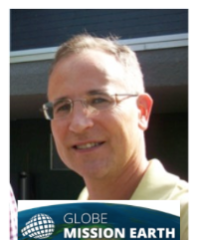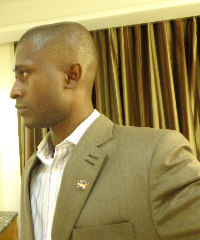Community Blogs
Community Blogs
Discover how the GLOBE community is engaging in all things GLOBE through the community blog posts below.
Learn how to create a GLOBE community blog post.
Filter By:
Blogs List
Hi Everyone,
The Thursday before the launch of SMAP was a day of much anticipation and excitement. We were ready to go, but high upper winds caused the cancellation of the launch four minutes before lift-off. You might be wondering how we monitor wind conditions at high altitudes (in this case, thirty four thousand feet). We do it by sending up weather balloons ahead of time to make these measurements where the rocket will be flying. The last balloon data came down just minutes before launch indicating that the winds exceeded conditions for a safe launch. Afterwards, inspections ...
Read More »
Posted in:
The Palmyra Cove Nature Park is a 250 acre open space in New Jersey. The park is located on the Delaware River about 7 miles north of Philadelphia, PA. You can check the site out by using Google Earth … (40 N, 75 W).
There are various land cover types, resulting in varying ecosystems within the park. There is a tidal cove (with wetlands), forest, river/beach, and an Army Corps of Engineers dredge cell. The South Jersey/Eastern Pennsylvania/Delaware region, known as the Delaware Valley, is an interesting and often tricky forecast region, even for the National weather Service (NWS). It ...
Posted in:
Hi Everyone,
My name is Erika Podest, and I am a scientist at JPL working on the SMAP mission. I’ll be writing about SMAP’s debut into space and providing updates during this exciting time. Welcome to my first post!
As a child growing up in tropical Panama and enjoying its exuberant nature, I always had a love for the environment. I went from playing in nature to studying it, and focused my research on the use of satellites to study Earth. As a doctoral candidate, I did part of my research as an intern at JPL, and this opportunity led me to ultimately become a scientist at JPL. ...
Posted in:
Introduction: The Global Precipitation Measurement Mission and GLOBE Student Field Campaign
by Kristen Weaver, GPM Education Specialist
My original topic for this introductory blog was going to be how to participate in the field campaign, but those details are well covered in the " How to Participate " section. For any technical questions, the GLOBE Support Team is always helpful, or for other questions about the campaign you can get in touch with me and/or the rest of the GPM Education Team here .
So that taken care of, the question becomes: Why should you contribute ...
Posted in:
There have been 28 schools that have entered data associated with the GLOBE Surface Temperature Field Campaign for a total of 782 observations. The number of observations for a school is in parenthesis.
Al-Fath Secondary School at Abha, Saudi Arabia
Brazil High School, Tinidad and Tobago (18) – Thank you Mr. Ali
Camanche Elementary School, Iowa, USA
Chartiers-Housgon Jr./Sr. High School, Pennsylvania, USA (8)– Thanks Gary
Chia-Yi Girls Senior High School, Taiwan (9)
Dr. Bessie Rhodes School of Global Studies, Illinois, USA, 8 different sites (41)
Feng-Shan Senior High ...
Posted in:
My passion towards Global Precipitation Measurement Mission started when I visited GPM Clean Room at Goddard Space Flight Centre in August 2013 during 18 th GLOBE Annual Partner Meeting in Maryland, United States. Having received a grant from the National Science Foundation (NSF) through University of Toledo, Ohio to participate in the event gave me reasons to maximize the opportunity. As a scientist from Nigerian Space Agency, this opportunity gave a rare privilege to contribute to the development of Environmental Education (EE) in my resource-constrained country and the world at large. ...
Posted in:
Field Campaigns:
GPM
Hi GLOBE surface temperature enthusiasts. The first week of the GLOBE Surface Temperature campaign (plus a couple days) is over. I took at look through all of the data that has been submitted so far. The field campaign looks to be a great success again. I greatly appreciate all of your hard work. 17 schools have entered data so far from 4 countries.
The number of observations for a school is in parenthesis.
Sekundarschule Uzwil, Switzerland (2) – Thanks Markus
Shazar Intermediate School, Israel (12)
Al-Fath Secondary School at Abha, Saudi Arabia (2)
Princeton ...
Posted in:
Citizen science is scientific research conducted by amateur or nonprofessional scientists. Formally, citizen science has been defined as "the systematic collection and analysis of data; development of technology; testing of hypotheses; and the dissemination of the resulting information by researchers on a primarily avocational basis. When students do science, it is citizen science. This is true when students take measurements and report their data or analyze data taken by themselves and others. It is particularly true when they complete research projects by reaching evidence-base ...
Posted in:
GLOBE Surface Temperature Field Campaign
December 1 to December 31, 2014
The GLOBE Program will host the annual surface temperature field campaign from December 1 to December 31, 2014. This is a great opportunity to work as a community with schools around the world on a common research project. Students have used the surface temperature field campaign data to do research projects. And, one of my graduate students has been looking at the data and found that a strong warming due to urban areas is observable in the student data. It is my hope that continued expansion of the ...
Posted in:
In the early 1980’s, I chaired a group of scientists exploring the idea of a comprehensive satellite mission to study all aspects of the global environment. The group was diverse with expertise covering the range of Earth science disciplines from geology, ecology, oceanography, limnology, glaciology, and atmospheric science and their various sub-disciplines. Their first recommendation was take today’s data today.
In all of Earth science there is the recognition that we have only one Earth to study. How Earth works is revealed by watching it change in a comprehensive manner and ...
A version of this blog was originally posted on November 14, 2012 .
If you have been listening to the news or following along with weather and climate web pages, you have probably heard the term "ENSO." ENSO, or El Niño-Southern Oscillation, is a quasi-periodic climate pattern that occurs in the tropical Pacific Ocean. When the conditions change, the atmosphere responds in many different ways. In certain locations, it is cloudier and it rains more, while in others it’s clear and dry. Scientists are forecasting El Niño conditions to start ...
Posted in:
Curriculum:
SCIENCE AND MATH
GLOBE Science Topics:
CLIMATE
Investigation Areas:
ATMOSPHERE
We had an incredible turn out at our (the GLOBE) table at the NOAA booth at the NSTA conference. It was great to meet so many teachers and curriculum directors with an interest in GLOBE. Thanks to everybody who took the time to stop by and learn about GLOBE.
For those people who did not get the Earth System Science Poster , we are very sorry. Please follow this link to get the PDF files so that you can print out the pages to use in your classroom. The page also has a complete poster that can be projected or printed, and the activities guide.
Expanding on the ESS poster ...
Posted in:
GLOBE Science Topics:
MEETINGS/CONFERENCES
News Topics:
TRAINING
Primary Audience:
PARTNERS
TEACHERS
Now that the new year is upon us, we can take a look at the GLOBE Surface Temperature field campaign from December 2013. I think it went very well. Tens of schools and thousands of students participated. Valuable data was collected that students can use to create research projects.
Here are the schools that have entered data so far.
David Wooster Middle School, Connecticut
Bellefontaine High School, Ohio – Hi Dennis
Birchwood School, Ohio – Hi Linda
Main Street Intermediate School, Ohio – Hi Marcy
Archbold Middle School, Ohio
The University of Toledo, Ohio – These are ...
Posted in:
Schools in Greece Participate in Earth Observation Day Via Donation from West Virginia University
West Virginia University faculty member and GLOBE scientist Dr. Rick Landenberger provided students at five Greek schools with scientific equipment to participate in Earth Observation Day, a STEM (Science, Education, Engineering, and Mathematics) educational event organized by the AmericaView consortium in partnership with the international SATELLITES Program and GLOBE. The schools included the 6 th Gymnasium of Volos, the 3 rd Lyceum of Aigaleo, the Gymnasium of Tinos, the 1 ...
Posted in:
Blog originally posted on the GLOBE Scientists' Blog: blog.globe.gov/sciblog/2013/04/03/the-most-important-step-in-science-communicating-your-results/
I remember in high school that I liked science and math much more than my grammar and literature classes. I recall thinking that if I pursued a career in science, I wouldn’t have to worry about reading and writing and I could really focus on the things I most enjoyed. Boy was I wrong, and quite ignorant to boot! In my scientific career, I read and write all of the time, and have come to really value and ...
Posted in:
The cold weather this last month has led to Lake Erie developing ice cover. This past week, the temperature has been averaging about 20 F (-6 C). Even with temperatures in the 50s and 60s F (10 C to 15 C), ice has formed. See the Figure 1 below.
As you can see in the picture, the ice on Lake Erie is broken up into things that look like islands. The wind blows the ice around and breaks it up. There is a straight line through Lake St. Clair that extends down into Lake Erie. What do you think caused this straight line? Usually, on Earth, straight lines are produced by humans. ...
Posted in:
Most trees obtain water through their massive root systems, but did you know that some trees can absorb water through their leaves as well? This ability is called foliar uptake. Scientists recently discovered that trees in cloud forests use foliar uptake to obtain water. A cloud forest is a forest that has persistent or seasonally persistent fog or low-level cloud cover. Cloud forests are usually in the tropics or subtropics, have evergreen trees (trees that don’t lose their leaves) and tend to have a lot of mosses and vegetation in the understory of the trees.
Cloud Forest ...
Posted in:
GLOBE Science Topics:
EARTH SYSTEM SCIENCE
Investigation Areas:
EARTH AS A SYSTEM
BIOSPHERE
GLOBE’s Earth as a System investigation area cultivates students’ awareness of an intricate web of global connections. Similar to real world scientists, students explore life science concepts, learning that “ organisms can only survive where their needs are met. ” The Earth as a System investigation area encourages students to observe patterns and connections, such as through phenology. Phenology is the study of how living organisms respond to seasonal changes in their environment. Only through observing and measuring can we notice if changes are occurring and how they occur. ...
Posted in:
GLOBE Science Topics:
EARTH SYSTEM SCIENCE
Investigation Areas:
EARTH AS A SYSTEM
Blog originally posted on the GLOBE Scientists' Blog: http://blog.globe.gov/sciblog/2012/12/19/the-chicken-and-egg-story-of-global-warming-and-extreme-droughts-a-lesson-on-climate-feedbacks/
I recently read that the extreme drought in western North America during 2000-2004 actually resulted in more carbon dioxide being released into the atmosphere. In the article in Nature Geoscience , it explained that such droughts can further enhance global warming. When a drought occurs, the plants wither and die and no longer uptake carbon dioxide (normally living plants serve as a ...
Posted in:
GLOBE Science Topics:
CLIMATE
CLIMATE CHANGE
Storm Coming Across US
If you live in the United States, you probably have heard of the snow storm crossing the country right now. There will be mountain snow in the Rockie Mountains, a potential for a blizzard from Nebraska to Wisconsin and then some snow to the Great Lakes states.
The National Weather Service (NWS) definition of a blizzard is:
"A blizzard means that the following conditions are expected to prevail for a period of 3 hours or longer:
Sustained wind or frequent gusts to 35 miles an hour or greater; and
Considerable falling and/or ...
Posted in:
—
20 Items per Page















